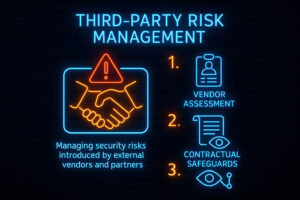From The Desk of the CISO
Vendor Risks for Small and Medium-Sized Businesses
By Rob Ashcraft, CISO at KeyStone Solutions

Small and medium-sized businesses (SMBs) are increasingly reliant on third-party vendors to support critical operations, from IT services and cloud platforms to financial management and operational tools. Subsequently, this reliance introduces multiple risks that many SMBs are ill-equipped to manage. Unlike large enterprises with dedicated vendor risk teams, SMBs often lack the resources, experience and appropriate frameworks to assess, monitor, and mitigate third-party risks effectively. Naturally, this gap makes SMBs and their “upstream vendors” attractive targets for cybercriminals, especially when vendors have access to sensitive data or internal systems. A single vulnerability in a vendor’s environment can cascade into a full-blown breach, disrupting operations and damaging customer trust.
What I would consider the most pressing vendor risks for SMBs are: cybersecurity vulnerabilities, regulatory non-compliance, operational disruptions, and reputational damage. In fact, according to Qualysec‘s 2025 statistics on small businesses, 60% of SMB cyber breaches originate from a third-party or upstream vendor. Regulatory frameworks such as GDPR, HIPAA, and CCPA require businesses to ensure their vendors meet strict data protection standards. Failure to do so can result in fines, lawsuits, and loss of business. Operational risks are also a concern for SMB’s with larger third-party vendors as they experience outages, supply chain failures, or mismanagement incident response. Moreover, reputational harm from vendor-related incidents can be devastating, especially for businesses that rely heavily on customer loyalty and word-of-mouth referrals.
To address these risks, SMBs must adopt a structured third-party risk management program (TPRM). This includes identifying critical vendors (those essential to daily operations or with access to sensitive data) and conducting thorough financial and security reviews before onboarding. Tools like vendor security questionnaires or audited risk assessments (e.g., SOC2 or ISO 27001 reports), penetration test summaries, and financial statements can help assess a vendor’s security posture. Ongoing third-party monitoring is equally important as a vendor’s risk profile can evolve over time. I recommend reassessing all critical third-party vendors on an annual basis. Businesses should also clearly define roles and responsibilities in vendor agreements, establishing incident response protocols, and an agreed process of maintaining communication of cyber incidents.
Government agencies like CISA have published practical guides to help SMBs operationalize TPRM, offering templates and checklists tailored to common use cases such as cloud-hosted solutions and managed service providers. SMBs can also consult with a resource that has experience in TPRM on how to build resilience against third-party threats. Ultimately, vendor risk management is not just a cybersecurity issue, it’s a business imperative that safeguards operations, ensures compliance, and protects reputation in an increasingly interconnected digital landscape. At KeyStone Solutions, we have helped many SMBs develop a strategy, polices, and processes to maintain due diligence with third-party risk management.

